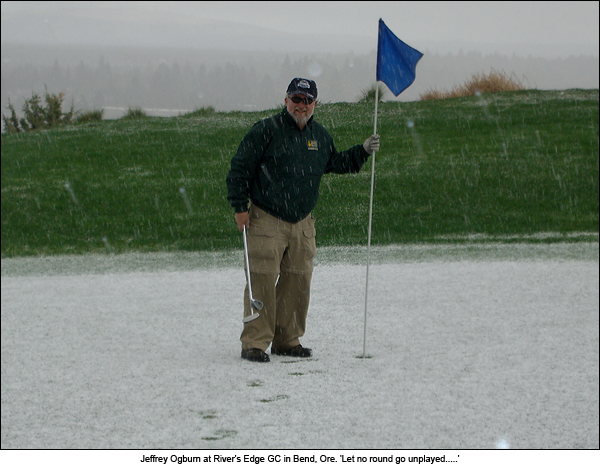Winter of our Discontent?
Not anymore, in the ‘winter-smart’ Northwest. A few common-sense ways to beat the elements
by Blaine Newnham

Is it difficult to think about golf when the days are dark, when temperatures barely reach 40 degrees, and a “good” rain is when the drops don’t bounce?
Not for me it isn’t.
There were winters when I traveled a lot, and took the clubs and tried to find a decent place to play, like in Los Angeles.
If I did, I was looking at a five-hour round. The frustrating crawl to get in 18 holes somehow preempted sun and 70 degrees.
Would I rather pull on a sweater and pull down a bucket hat to walk fairways in solitude in the Northwest? Absolutely.
While our winters seldom change, the conditions of our courses have.
On most of our Northwest courses we no longer lose balls in the middle of fairways, or even find them embedded.
Nor are we forced to tee it up on a rubber doormat, or wear rubber boots with spikes on the bottom of them.
New courses were suddenly sand-capped when they were built. Sand was an answer, but so was digging in miles of drainage pipe. Together they produced playing areas that if they didn’t cause the ball to bounce, they at least kept it from disappearing.
It was suddenly possible to mow fairways in the winter without doing damage to them. The more they were mowed the quicker they dried out.
The culprit – besides all the rain – is thatch, or the buildup of dead organic material. Sand penetrates thatch.
We don’t hit off mats anymore because our teeing areas are more robust, largely because of the selective removal of trees south and east of the tee.
Sunlight is vital to the growing of grass.
There was even a difference in the speed of greens. No longer were winter greens left in a rather shaggy state to hibernate. Green speeds approached those of summer. Surrounds didn’t suck up approach shots. This was real golf, at lower prices and with fewer waits.
So, as courses improved so did clothing. It’s the technology.
It was 39 degrees as I left the house one morning en route to Chambers Bay with the cigarette pack-sized battery for my Mobile Warming rain jacket fully charged.
A couple of hours later, with the dial set at 75 percent, I thought I was in a sauna. I needed to figure how much clothing to wear, and which of the battery setting I needed to use. The warmer the setting, the less battery life, but so far I’ve had no problems getting around 18 holes, and the seven-mile walk at Chambers Bay.
Everyone I talked to about the jacket – created by a Milwaukee, Wis. company – was intrigued by it to the point I got tired of guys pawing me trying to figure out where the wires were.
The wires run parallel down your front. The jacket is advertised as waterproof but, frankly, I haven’t been out enough in the rain yet to be sure of that.

Without the need to wear three sweaters, the movement to generate some club head speed – especially in winter – is greatly enhanced. According to one pro, women are particularly appreciative of the new technology.
For me, a good day on the links in winter means walking. I find it far warmer to walk than ride a cart, although the cart can provide a warm hut against a squall. In a downpour, who can despise a cart rigged with side curtains like my old TR3, a small propane heater and a slug of single-malt Scotch.
After the need to walk, most important to me is keeping my feet and neck dry, and having appropriate gloves to keep my hands on the club. There’s little more important than a hat that keeps water off your neck. Don’t overlook the value of a towel or scarf around your neck, either.
On a day that is just cold, I pull a stocking cap over my ears. Sometimes, around here, I carry three hats in my bag – a stocking cap, a baseball cap and a bucket hat. And use all three in the same round.
Beyond that it is layers. Good long underwear is essential, and I spent the most money on a rain suit that is light and breathable and actually keeps the rain out.
When it is really cold, I use fleece golf mittens that allow me to slip my hands out of the gloves to grip the club while the gloves are still attached to my wrists.
As far as rain, the cotton rain gloves are terrific. The more it rains, the better your grip on the club. No longer is the worry that the club is going to slip – or even leave – your hands.
I’ve made wool socks part of my wardrobe. The Kentwool brand is yummy.
Among other new items I’ve tested is a long-sleeve polo shirt, perfect to wear over a thin layer of long underwear. The manufacturers tell you the shirt will actually make you hit the ball farther. Not sure about that, but the shirt will help you stay warm.
The new stuff just isn’t as bulky as it used to be. You feel liberated, especially when the rain ebbs and your tee shot actually bounces a couple of times.
Life is good.
Blaine Newnham is a former columnist and sports editor for the Eugene Register-Guard and columnist and associate editor for the Seattle Times. He likes to play golf, rain or shine.





